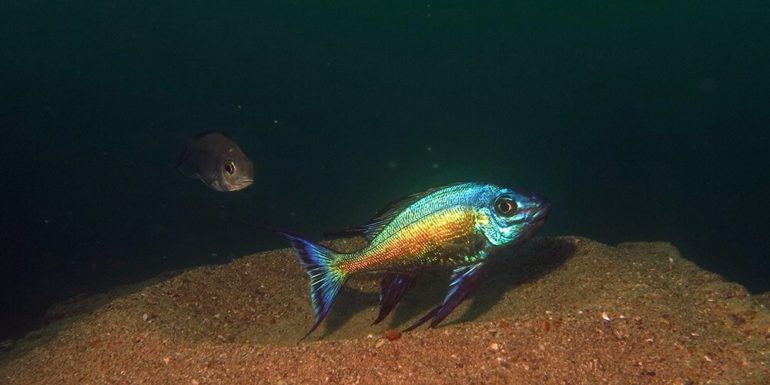The cichlids of Lake Tanganyika in Africa are highly diverse—including with regard to sex chromosomes. These have changed extremely frequently in the course of the evolution of these fish and, depending on the species, can be of the type XY or ZW. This has been reported by a research team from the University of Basel and the Research Museum Koenig in Bonn in the scientific journal Science Advances.
Based on the biology lessons back in our schooldays, we know that XX means female, and XY means male. In mammals, these constellations of sex chromosomes determine whether an individual becomes a female or a male. It is different in birds, where the principle of ZW = female, ZZ = male applies. In many reptiles, the temperature at which the eggs develop determines the sex. The way in which genetic sex is determined can therefore vary from species to species, with different sex-determining systems having occurred during evolution. In fish, the most biodiverse group of vertebrates, we find different genetic systems (including the XY and ZW types of mammals and birds, respectively) as well as environmental systems (as in many reptiles).
The evolution of sex chromosomes
Sex chromosomes are derived from “normal” chromosomes—the autosomes—after acquiring a new, sex-determining mutation. The resulting new chromosome pair takes separate paths in the course of evolution, ensuring that there is no exchange of sex-determining genes between the two sex chromosomes.
In mammals, this process took place around 165 million years ago, and resulted in the XY system with a male-specific Y chromosome. In birds, the W is a female-specific chromosome. In fish, on the other hand, it has been known for some time that there is no general sex chromosome system.
With the aid of next-generation genome sequencing methods that allow for a comparison between the genomes of both sexes, a new world of sex chromosomes has been identified in fish: During their evolution, different chromosomes have developed independently of each other in different fish lineages as sex chromosomes. Yet, the repeated appearance of similar or functionally related sex-determining genes suggests that there is a pool of chromosome candidates that are particularly suitable for sex determination.
Cichlids are especially diverse
A research team at the Department of Environmental Sciences at the University of Basel led by Dr. Astrid Böhne (now at the Research Museum Koenig in Bonn) has now investigated the evolution of sex chromosomes in a highly diverse group of fish, the cichlids from Lake Tanganyika in Africa. A particular feature of these fish is that they are a prime example of adaptive radiation, a process in which a large number of species emerge in a relatively short time through rapid adaptation to various habitats.
The researchers analyzed extensive genome and transcriptome data of around 240 cichlid species for differences between females and males, which enabled them to identify sex chromosomes in over 70 species. Interestingly, substantial differences between the species became apparent with regard to the chromosomes responsible for sex determination. The course of the evolution of cichlids in Lake Tanganyika also saw several changes from sex chromosomes of type XY to ZW and vice versa.
Frog with six sex chromosomes provides clues to evolution of complex XY systems
More information:
Athimed El Taher, et al, Dynamics of sex chromosome evolution in a rapid radiation of cichlid fishes. Science Advances (2021). DOI: 10.1126/sciadv.abe8215
Provided by
University of Basel
Citation:
Highly dynamic sex chromosomes in cichlid fishes (2021, September 3)
retrieved 5 September 2021
from https://phys.org/news/2021-09-highly-dynamic-sex-chromosomes-cichlid.html
This document is subject to copyright. Apart from any fair dealing for the purpose of private study or research, no
part may be reproduced without the written permission. The content is provided for information purposes only.



